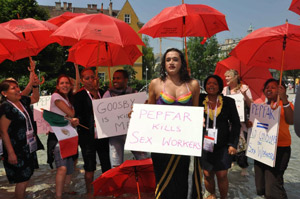
Wikimedia Commons
An adult-film performer tested positive for HIV last week, leading several production companies in Los Angeles County to halt filming indefinitely to contain a potential outbreak, the Los Angeles Times reports. The news is rattling a multi-billion dollar industry that routinely tests performers for the virus but does not require them to wear condoms. And therein lies the problem, says Michael Weinstein, president of AIDS Healthcare Foundation. The medical provider filed a lawsuit against LA County’s Department of Public Health last year to force it to mandate condom use in the porn industry. The foundation lost that case, but it’s appealing. “In any other job, we require companies to protect their workers even if it costs more money for the employers,” Weinstein told me over the phone. “Why should the porn industry be any different?”
The main argument made by actors, directors, and producers against requiring condoms in porn is viewers don’t want to see them so it’ll hurt sales. Vivid Entertainment founder Steven Hirsch told LA Weekly in January that when Vivid went “condom-only,” between 1998 and 2006, it saw a 10 to 20 percent drop in revenues. Then last week, Vivid suspended all film production due to one HIV-positive performer. I emailed Hirsch to ask him how much money his studio anticipates losing during the hiatus, but he has yet to reply.*
The gender and work history of the HIV positive performer, and the date when the test came back positive, have yet to be released by the Adult Industry Medical Healthcare Foundation, a nonprofit that offers medical services to sex workers. But rumor has it the perfomer is a man who’s worked in both straight and gay porn; those potentially infected could be in the hundreds. An estimated (PDF) 2,000 to 3,000 porn performers work in the San Fernando Valley—the porn capital of the United States—starring in the more than 10,000 adult films made there yearly.
Back in January, Weinstein told LA Weekly: “There’s no other workplace where people routinely get diseases and no one does anything about it.” Although porn industry standards require actors to get tested every 30 days, the lack of preventative measures enforced by studios have made sexually transmitted diseases a scary norm within the profession’s ranks, especially among women. Between 2004 and 2008, LA County’s Department of Public Health (PDF) logged in more than 3,200 cases of chlamydia and gonorrhea. Seventy-five percent of the reported cases were in female performers; 25 percent of all female performers were reinfected within one year. As many as 22 performers have tested positive for HIV since 2004, the notorious year when porn star Darren James infected 3 of the 13 women he had sexual contact with during the six month window period before the virus showed up on his monthly tests.
“Gay porn is done primarily with condoms and it has been for the last 20 years,” Weinstein tells me. “Their business is still going strong. If there was a level playing field and every company was required to wear condoms, then it would not affect one company.” On October 25, California’s Division of Occupational Safety and Health is holding its second hearing in Oakland to review condom use in the state’s adult film industry. Weinstein, who’s petition launched the investigation, is optimistic about the verdict to come: “I believe ultimately that there will be more [safe sex] enforcement and the porn industry will be required to use condoms.
*UPDATE: Steven Hirsch, the founder of Vivid Entertainment, emailed me this statement today: “We haven’t had any decline in sales because we’re in the fortunate position of having several months of movies in various stages of post production. We don’t expect this situation to change unless production remains closed for an extended period of time.”














